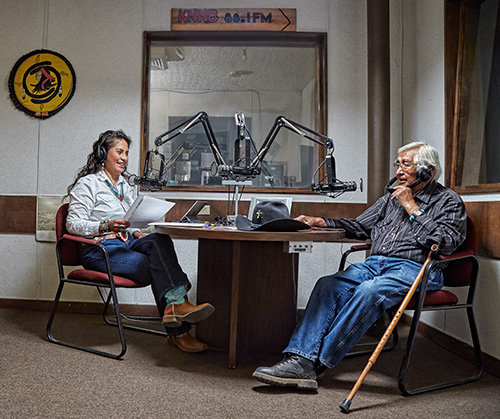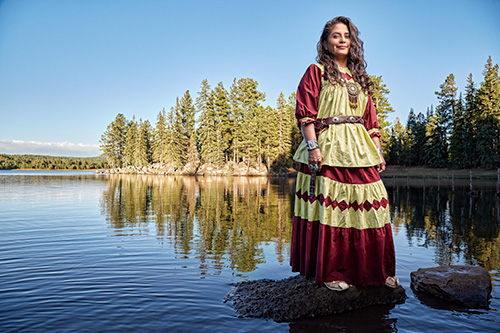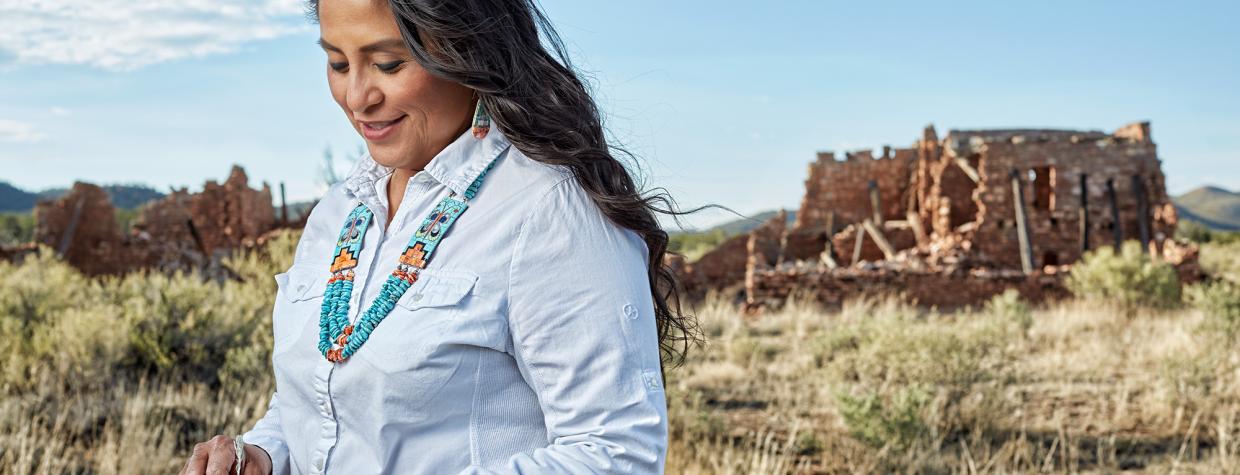On Day 47 of her administration, the White Mountain Apache Tribe’s first elected chairwoman stands on a podium at Hon-Dah Resort. Wearing cowboy boots and a rodeo-style belt buckle, Gwendena Lee-Gatewood is dressed much like the Southwest Indian Agricultural Association members she’s here to welcome.
A former rodeo queen whose father and brothers were well known as “the Lee boys” on the circuit, Lee-Gatewood looks younger than her 47 years. The long hair falling in waves across her shoulders shines in the lights like polished obsidian, and her smile is as flawless as a toothpaste ad model’s.
“Good morning!” she beams brightly.
“Come on!” she says, after a few muttered responses. “Good morning!
“I really wanted to be here to welcome all of you,” she continues. “Being around people who are part of livestock and agriculture reminds me of how I grew up. We had to plant every year, and we had horses, because we had to go to the rodeos. … And I want that for our children. Because it teaches you hard work, and it teaches you to appreciate the land, and it teaches you to respect … the way of life our ancestors had.”
Lee-Gatewood learned about that way of life from her parents, as did most of the approximately 13,000 Apaches who live on the tribe’s land. That territory, which covers more than 2,500 square miles of Eastern Arizona, includes Fort Apache Historic Park, Sunrise Park Resort and a wealth of popular fishing, hunting and camping sites.
When elected in April, Lee-Gatewood joined an increasing number of women to achieve the highest level of tribal leadership. In 1990, the Bureau of Indian Affairs reported that among federally recognized tribes, only 61 women held their nations’ highest office. By 2014, that number had grown to 147 — about 26 percent. By comparison, 12 percent of American governors are women, as are 22 percent of U.S. mayors of cities with populations of 30,000 or more.
In Arizona, the numbers are higher. Of the state’s 22 tribal leaders, seven, or 32 percent, are women. One of those women also heads the Inter Tribal Council of Arizona, and another runs the Arizona Indian Gaming Association.
In most respects, Lee-Gatewood fits the pattern of women leaders in Southwestern tribes. According to one study, they’re generally in their late 40s or early 50s, are college-educated, speak their Native language as well as English, and have a live-in partner and grown children who live away from home. Lee-Gatewood differs only in that her youngest child, a senior in high school, still lives with her and her husband.
Wrapping up her welcome at Hon-Dah, Lee-Gatewood says, “God bless each and every one of you,” then exits quickly through a side door, hustling off to her next commitment.

One of Lee-Gatewood’s closest associates describes her energy as “relentless” and her perseverance as “something to behold.” And these early days of her administration have required both qualities.
“Yesterday, we had the Arizona Indian Gaming Association meeting here,” she says. “Today, there’s a field trip up at Hawley Lake. We have the meeting with the tribal courts tomorrow. Then we have a carbon-credit meeting on Thursday.”
On Friday, Lee-Gatewood will travel to Albuquerque for a meeting of the Apache Alliance, then head to Washington, D.C., to lobby for a bill to allow the tribe to proceed with improvements to its water system. (The bill will pass Congress the following month.)
“It’s just a busy schedule,” she says, thumbing through her phone. “And my email and text message is forever going. Tribal members will come over to the house or the office at any given time. Sometimes they will come on weekends, at night, with their concerns.”
“Gwendena!” someone calls, as if on cue. This will happen over and over on this day: in the drive-thru at McDonald’s; coming out of the tribe-owned radio station after her weekly broadcast; walking to her car from the historic Theodore Roosevelt School, where she serves as board president.
A tree fell on their house, or they want to know whom to talk to about getting a gate in the fence behind their home, or they need money for the bus. Each time, Lee-Gatewood listens patiently, hands out her business card, says to email her with the details. She will see what she can do.
“When I’m home, I’ve got dishes to do, I’ve got clothes to wash, a floor to sweep, house to mop,” she says. “My job at home doesn’t end just because I have this job. I’m doing that, too.”
Up at 5 a.m., as on most mornings, Lee-Gatewood began her official duties on this day at 7, meeting with the recently hired principal of McNary
Elementary School. “She’s been having some challenges, and she wanted my assistance,” Lee-Gatewood explains. She told the principal to listen to her constituents and follow school policy.
“No matter what you do, you’re not going to please everybody,” she said. “Do what you can to work with them, and they’ll realize sooner or later that your heart’s in the right place.”
Lee-Gatewood grew up in Show Low. Her father, who had a second-grade education, worked in a lumber mill there. Though they lived in town, the family spoke Apache at home and remained close to relatives on tribal land. And even after her parents had been baptized, they took their children to Sunrise Ceremonies and other events.
“Because that’s how they grew up,” Lee-Gatewood says. “My mother would use that opportunity to tell us, ‘This is why they’re doing that. This is why they’re doing this.’ And the dos and don’ts of proper etiquette as it relates to our culture.”
The youngest of 11 children sharing a three-bedroom house, Lee-Gatewood slept on the floor. “You had to prove yourself, because siblings are going to give you a hard time,” she says with a laugh. “Growing up in that environment, and going to school with a majority of white children — some of them would pick on me for the color of my skin, and call me names, and try to bully me at recess — it kind of thickened my skin.”
Pulling out several pieces of foam core from the back seat of a rented SUV, she says, “These are some pictures I had for my inauguration.” In a grainy black-and-white photo, a young girl with long braids and ill-fitting pants clutches a stuffed Sylvester the Cat.
“This is me when I was 8 or 9 years old,” she says. “I use this to talk to children at the tribe. I’ll say, ‘Look, this was me. I didn’t have the best of clothes. All I had was a bike and this toy. The kids at school would pull on my braids. But look at where I’m at now. Don’t let your circumstances dictate your future. Use it to motivate you.’ ”
“No matter what you do, you’re not going to please everybody. Do what you can to work with them, and they’ll realize sooner or later that your heart’s in the right place.”
— Gwendena Lee-Gatewood
Lee-Gatewood married and had her first child while still in college, ultimately raising three kids as a single parent before remarrying in 2016. “There were times where I had [to work] two or three jobs just to pay the bills,” she says.
After graduating from Northern Arizona University with a degree in business administration and human resources management, Lee-Gatewood worked as the tribe’s HR director. Then, 12 years ago, Chairman Ronnie Lupe recruited her to work as one of his executive assistants — a job that ultimately prepared her to take the reins when her boss decided not to run for a 10th term.
“I’m glad she won,” Lupe says. “She’s very kind to people. And she’s very intelligent. She’s humble, but very strong in representing the White Mountain Apache Tribe, and that will secure her position as a woman to be respected. She is expected to clear the road by the people. And she’ll know what to do.”
Tribal cultures and governments vary widely. Women have played important cultural roles in many tribes. In government, Navajo and Pascua Yaqui women have participated formally for more than 100 years, while women in the Ak-Chin and Salt River Pima-Maricopa Indian communities began holding leadership positions in their governments in the 1950s and ’60s, about the time non-Indian women got more involved in politics.
Education is an increasingly important factor. In 1976, about the same number of Native American men and women were enrolled in colleges and universities. By 2006, though, 61 percent of Native Americans in college were women. Over that 30-year period, the number of Native women earning advanced and professional degrees quadrupled.
Particularly significant is the number of Indian women who have held professional or managerial positions, says Diane-Michele Prindeville, who holds a doctorate in political science and has studied female leadership in Southwestern tribes over the past 20 years. Those women are bringing concepts such as transparency and accountability back to Native governments that are increasingly involved in running tribal enterprises.
One of the biggest factors may be demographics. Like most Arizona tribes, the White Mountain Apache Tribe is young. Nearly 38 percent of the population is under 18, according to 2010 census data, and only 5.5 percent is over 65. And women head nearly one-third of its households. For that population, having a woman in charge doesn’t seem strange, Prindeville says. “If you go beyond that, looking at the structure of the governments,” she adds, “there’s where you see a very large number of women.”
All these factors have created a pathway and an opportunity for women to enter positions of formal leadership.
The themes of Lee-Gatewood’s campaign wouldn’t surprise anyone who studies women in tribal politics. They included transparency, accountability, and preservation of natural resources and Native language. Lee-Gatewood expounds on these themes on social media and in her weekly radio show. As she’s vice chairwoman of the Pinetop-Lakeside Chamber of Commerce, it’s not surprising she also talks about the tourism that supports the tribe, encouraging members to offer hospitality and good service to visitors so they’ll come back.
Younger tribal members particularly appreciate Lee-Gatewood’s use of social media to communicate directly with constituents. Shortly after her inauguration, she fulfilled her campaign promise to livestream council meetings, posting on Facebook video of the first meeting, along with the names of council members who voted to allow it — and the names of those who didn’t.
In her inaugural address, Lee-Gatewood called for unity, and her age and background allow her to connect disparate elements: the tribe’s youths and elders, or tribal culture and the outside world. “She steps in as a chairwoman with enough experience not to have to learn the ropes,” says Jane Russell-Winiecki, elected chairwoman of Camp Verde’s Yavapai-Apache Nation in 2016. “Along with being professional and confident, she knows her culture, and that’s a wonderful combination.”

The inroads women have made into tribal politics have not always been smooth, or lasting. When Vivian Juan-Saunders became the first Tohono O’odham chairwoman, in 2003, she told a Tucson Weekly reporter: “When I first ran for office, there were many who felt that a woman doesn’t belong in the position I hold now, but I believe … it’s no longer a matter of gender, but a matter of who has the qualifications to move our nation forward.”
But Juan-Saunders was defeated in her 2007 re-election bid. Kathy Wesley-Kitcheyan, the first woman to lead the San Carlos Apache Tribe (the closest tribe, culturally and geographically, to the White Mountain Apaches), also served only one term as chairwoman. Did she feel resistance to her leadership as a woman? No, Wesley-Kitcheyan says. Not at first. “But I will tell you,” she adds, “after my four years were up and I was not re-elected, a council member told me … ‘You did good, and you had a lot of great ideas, but you were a woman.’ ”
Official barriers also remain. Most of the country’s Puebloan nations still prohibit women from holding office. The Hopis, Arizona’s only Puebloan tribe, are an exception. In the course of her research, Prindeville heard many women’s stories of harassment, primarily in the most conservative Puebloan tribes. And she notes that the majority of women she interviewed in Arizona during one study were in the midst of a recall — although, in more than one case, the opposition seemed less about gender than about efforts to increase transparency in tribal operations.
Ultimately, Prindeville says, the ongoing #MeToo movement will elevate women everywhere. “We’re seeing women running for state and local office, school boards and Congress like never before,” she says.
Lee-Gatewood feels some resistance to her gender, but she’s determined not to focus on it. “You’re always going to have opposition,” she says. “But that’s where you learn and you grow.”

